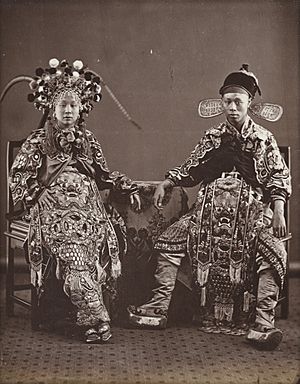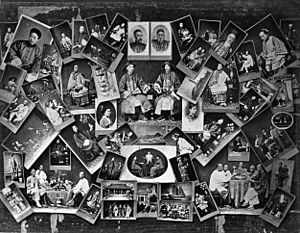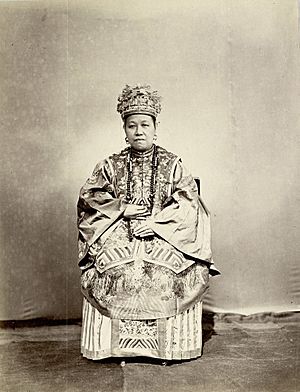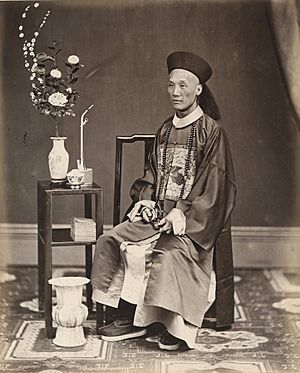Lai Afong facts for kids
Quick facts for kids
Lai Afong
|
|
|---|---|
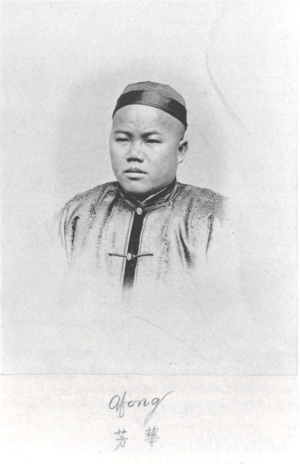
Lai Afong. c. 1870
|
|
| Born | 1838/1839 Gaoming, China
|
| Died | (aged 51) Hong Kong
|
| Other names |
|
Lai Afong (Chinese: 黎芳; born around 1838 or 1839 – died 1890) was a famous Chinese photographer. He started a business called Afong Studio. This studio became the most successful photography business in China during the late Qing Dynasty. Many people consider him the most important Chinese photographer of the 1800s.
Contents
Life as a Photographer
Lai Afong was born in Gaoming, a place in Guangdong, China. He moved to Hong Kong in the 1850s. He was a refugee because of a big war called the Taiping Rebellion. We don't know exactly how he learned photography. But it is said he knew how to take pictures by 1859. He used a method called the wet-plate collodion process. This was a common way to take photos back then.
Between 1865 and 1867, Lai Afong worked with a Portuguese photographer named José Joaquim Alves de Silveira. By 1870, he opened his own business, Afong Studio. He advertised his studio in the Hong Kong Daily Press newspaper.
Lai Afong took many different kinds of pictures. He photographed people, scenes from daily life, and beautiful city views. He also took pictures of landscapes. Not much is known about his personal life. But his amazing talent is clear in the many photos that still exist today. After Lai Afong passed away, his son took over the photography business in the 1890s.
Traveling for Pictures
Lai Afong traveled a lot to take photos. He visited many parts of China, like Fujian, Guangdong, Hebei, and Shanghai. He also took many pictures in Hong Kong. His collection included photos of famous Chinese buildings. These included places like the Summer Palace and the Fragrant Hills Pagoda in Beijing. He also photographed the Temple of the Six Banyan Trees in Guangzhou.
He also took amazing wide pictures called panoramas. These showed places like Victoria harbor and Gulangyu island. Lai Afong's fame grew quickly. Many people, both Chinese and foreigners, came to his studio for portraits. This included important Chinese officials like Li Hongzhang. He was even the official photographer for the Governor of Hong Kong, Sir Arthur Kennedy. He also took photos for Grand Duke Alexei Alexandrovich of Russia.
Lai Afong was very good at attracting customers from both China and other countries. He advertised in English newspapers. He said his studio had "a Larger, and more complete collection of Views than any other Establishment in the Empire of China." He also wrote captions for his photos in both Chinese and English. People from Hong Kong, other parts of China, and foreign visitors bought his pictures.
His studio became a place where foreign photographers came to learn. Photographers like Emil Rusfeldt and D.K. Griffith started their careers with Lai Afong. In 1875, Griffith said that Lai Afong was the best Chinese photographer in Hong Kong. John Thomson, a Scottish photographer, also praised Lai Afong's work. He said Lai Afong's pictures were "extremely well-executed" and "remarkable for their artistic choice of position."
Lai Afong was special because other foreign photographers respected his work. His photos were unique. Many of his pictures showed the style of traditional Chinese painting, called guóhuà. He also loved taking panorama photos more than any other photographer in China at that time. This made his work stand out. He is compared to famous landscape photographers like Carleton Watkins in America. No other Chinese photographer in the 1800s showed such a wide and varied view of China.
His Lasting Impact
In 2020, a museum called the Johnson Museum of Art at Cornell University held an art show about Lai Afong. It was the first museum show just for his work. Most of the photos came from the Stephan Loewentheil China Photography Collection. This collection has many important early Chinese photographs. Even though the show was cut short by the COVID-19 pandemic, it received great reviews. China's biggest newspaper, People’s Daily, said the show "truly [showed] the life of Chinese society in the 19th century."
Lai Afong was the most successful Chinese photographer of his time. His photos let us see China and its people through the eyes of a Chinese artist. This was before the big changes of the 1900s. For many years after his death, his work was not well known. But now, his photos in collections like the Stephan Loewentheil China Photography Collection are helping more people see his amazing art. You can find Lai Afong’s photographs in famous museums today. These include the Metropolitan Museum of Art and the J. Paul Getty Museum.
Finding Afong Studio Photos
It can be hard to know for sure who took some old photos from 19th-century China. This is because many records are missing or mixed up. When photographers closed their studios, they often sold their old photo plates (called glass plate negatives). Other photographers would buy them and make new prints. They would then sell these prints as their own.
Also, travelers would often buy photos from many different photographers. They would then put all these photos into one album when they got home. So, even if an album has a studio's label, it might have pictures from many different artists.
Even though Lai Afong was famous, it's still hard to know for sure which photos he took himself. The Afong Studio sometimes included photos from other artists in their albums. But Lai Afong was a "master photographer." He only used pictures from very good foreign photographers. As he traveled more, he replaced photos by others with his own views. Albums from Afong Studio made after about 1880 mostly contain only his own pictures.
Gallery
- Selected photographs by Lai Afong
-
A commercial street in Guangzhou
Albums
- Album of photographs of Peking and its environs
- An album mainly of landscape photographs of China
- From Afong, Photographer
- Images related to Shanghai and other Chinese cities
- People and views of China
See also
- Photography in China


